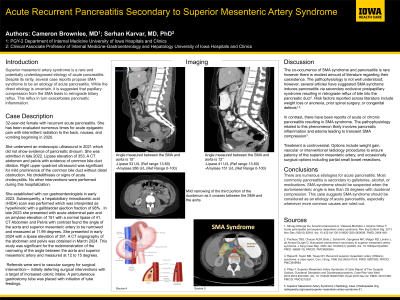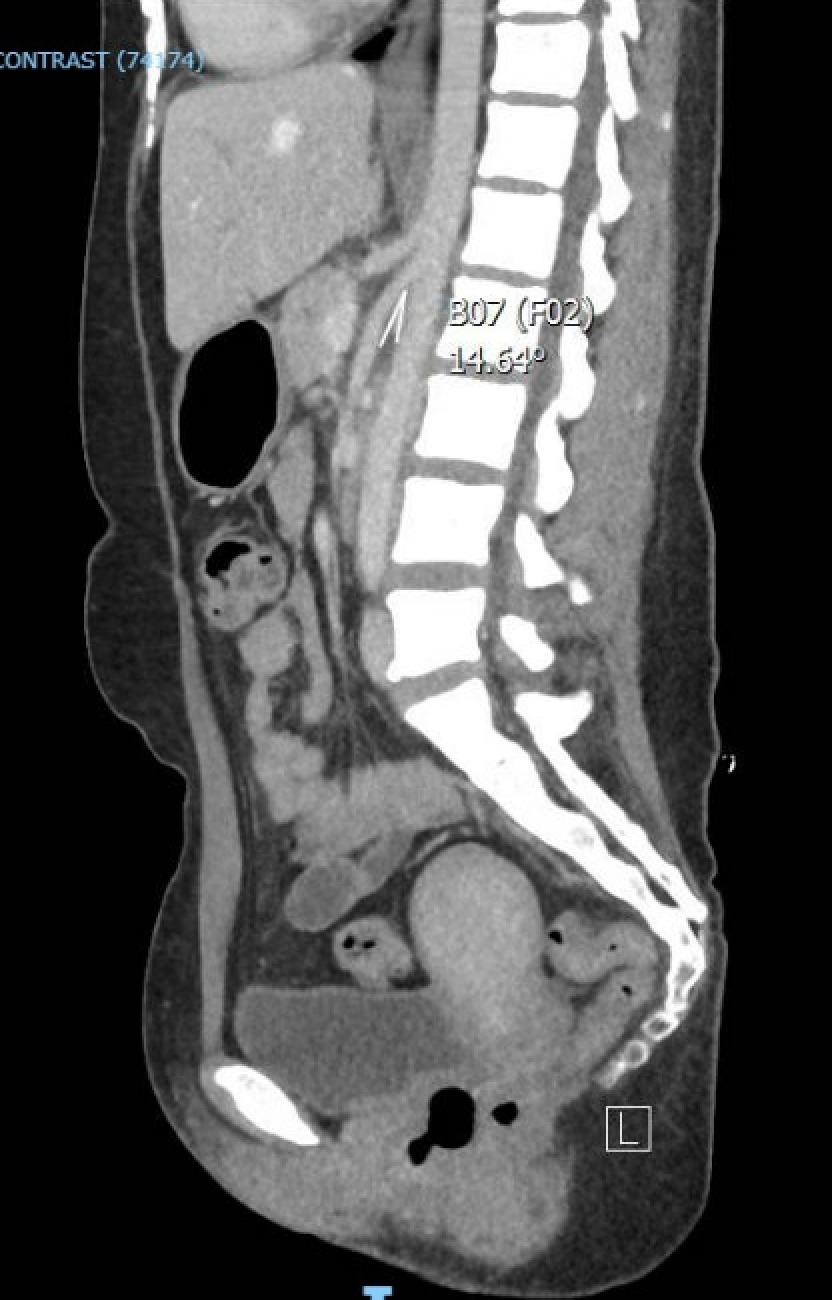Tuesday Poster Session
Category: Biliary/Pancreas
P3569 - Acute Recurrent Pancreatitis Secondary to Superior Mesenteric Artery Syndrome
Tuesday, October 29, 2024
10:30 AM - 4:00 PM ET
Location: Exhibit Hall E

Has Audio
- CB
Cameron Brownlee, MD
University of Iowa Hospitals & Clinics
Iowa City, IA
Presenting Author(s)
Cameron Brownlee, MD, Serhan Karvar, MD, PhD
University of Iowa Hospitals & Clinics, Iowa City, IA
Introduction: Superior mesenteric artery (SMA) syndrome is a rare and potentially underdiagnosed etiology of acute pancreatitis. Despite its rarity, several case reports propose SMA syndrome to be an etiology of acute pancreatitis. While the direct etiology is uncertain, it is suggested that papillary compression from the SMA leads to retrograde biliary reflux. This reflux in turn exacerbates pancreatic inflammation.
Case Description/Methods: A 32-year-old female with recurrent acute pancreatitis. She has been evaluated numerous times for acute epigastric pain with intermittent radiation to the back, nausea, and vomiting beginning in 2020. She underwent an endoscopic ultrasound in 2021 which did not show evidence of pancreatic divisum. She was admitted in late 2022. Lipase elevation of 353. A CT abdomen and pelvis with evidence of common bile duct dilation. Right upper quadrant ultrasound was significant for mild prominence of the common bile duct without distal obstruction. No cholelithiasis or signs of acute cholecystitis. No other interventions were performed during this hospitalization. She established with our gastroenterologists in early 2023. Subsequently, a hepatobiliary iminodiacetic acid (HIDA) scan was performed which was interpreted as hyperkinetic with a gallbladder ejection fraction of 98%. In late 2023 she presented with acute abdominal pain and an amylase elevation of 151 with a normal lipase of 41. CT Abdomen and Pelvis with contrast found the angle of the aorta and superior mesenteric artery to be narrowed and measured at 11.99 degrees. She presented in early 2024 with a lipase elevation of 391. A CT angiography of the abdomen and pelvis was obtained in March 2024. This study was significant for the redemonstration of the narrowing of the angle between the aorta and superior mesenteric artery and measured at 12 to 15 degrees. Referrals were sent to vascular surgery for surgical intervention— initially deferring surgical interventions with a target of increased caloric intake. A percutaneous gastrostomy tube was placed with initiation of tube feedings. Further clinical course is pending.
Discussion: There are numerous etiologies for acute pancreatitis. Most commonly pancreatitis is secondary to gallstones, alcohol, or medications. SMA syndrome should be suspected when the aortomesenteric angle is less than 25 degrees with duodenal compression. This case suggests SMA syndrome should be considered as an etiology of acute pancreatitis, especially whenever more common causes are ruled out.

Disclosures:
Cameron Brownlee, MD, Serhan Karvar, MD, PhD. P3569 - Acute Recurrent Pancreatitis Secondary to Superior Mesenteric Artery Syndrome, ACG 2024 Annual Scientific Meeting Abstracts. Philadelphia, PA: American College of Gastroenterology.
University of Iowa Hospitals & Clinics, Iowa City, IA
Introduction: Superior mesenteric artery (SMA) syndrome is a rare and potentially underdiagnosed etiology of acute pancreatitis. Despite its rarity, several case reports propose SMA syndrome to be an etiology of acute pancreatitis. While the direct etiology is uncertain, it is suggested that papillary compression from the SMA leads to retrograde biliary reflux. This reflux in turn exacerbates pancreatic inflammation.
Case Description/Methods: A 32-year-old female with recurrent acute pancreatitis. She has been evaluated numerous times for acute epigastric pain with intermittent radiation to the back, nausea, and vomiting beginning in 2020. She underwent an endoscopic ultrasound in 2021 which did not show evidence of pancreatic divisum. She was admitted in late 2022. Lipase elevation of 353. A CT abdomen and pelvis with evidence of common bile duct dilation. Right upper quadrant ultrasound was significant for mild prominence of the common bile duct without distal obstruction. No cholelithiasis or signs of acute cholecystitis. No other interventions were performed during this hospitalization. She established with our gastroenterologists in early 2023. Subsequently, a hepatobiliary iminodiacetic acid (HIDA) scan was performed which was interpreted as hyperkinetic with a gallbladder ejection fraction of 98%. In late 2023 she presented with acute abdominal pain and an amylase elevation of 151 with a normal lipase of 41. CT Abdomen and Pelvis with contrast found the angle of the aorta and superior mesenteric artery to be narrowed and measured at 11.99 degrees. She presented in early 2024 with a lipase elevation of 391. A CT angiography of the abdomen and pelvis was obtained in March 2024. This study was significant for the redemonstration of the narrowing of the angle between the aorta and superior mesenteric artery and measured at 12 to 15 degrees. Referrals were sent to vascular surgery for surgical intervention— initially deferring surgical interventions with a target of increased caloric intake. A percutaneous gastrostomy tube was placed with initiation of tube feedings. Further clinical course is pending.
Discussion: There are numerous etiologies for acute pancreatitis. Most commonly pancreatitis is secondary to gallstones, alcohol, or medications. SMA syndrome should be suspected when the aortomesenteric angle is less than 25 degrees with duodenal compression. This case suggests SMA syndrome should be considered as an etiology of acute pancreatitis, especially whenever more common causes are ruled out.

Figure: The angle of the superior mesenteric artery and the aorta is measured here at 14.64 degrees.
Disclosures:
Cameron Brownlee indicated no relevant financial relationships.
Serhan Karvar indicated no relevant financial relationships.
Cameron Brownlee, MD, Serhan Karvar, MD, PhD. P3569 - Acute Recurrent Pancreatitis Secondary to Superior Mesenteric Artery Syndrome, ACG 2024 Annual Scientific Meeting Abstracts. Philadelphia, PA: American College of Gastroenterology.
